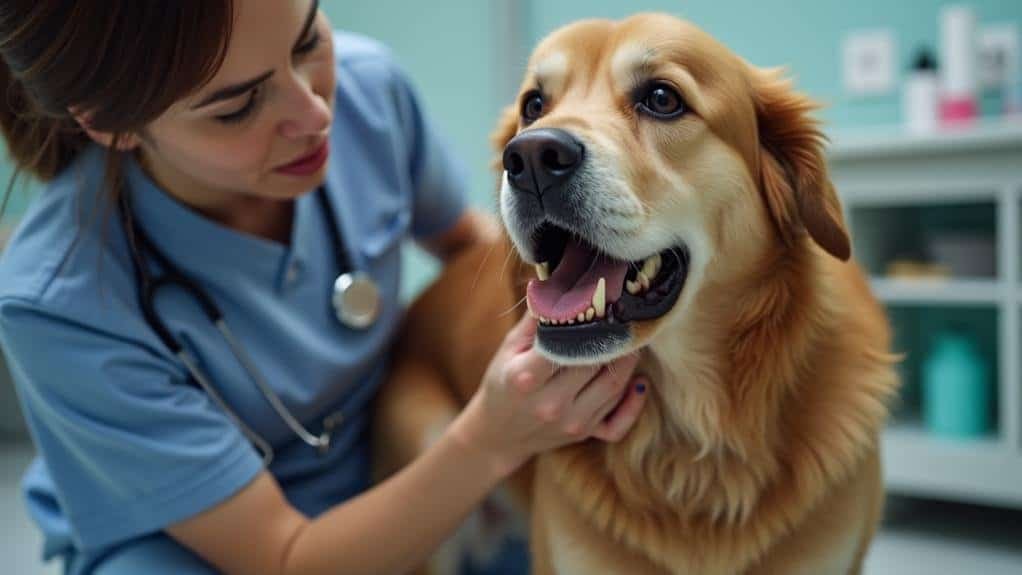If your male dog's private area is swollen and red, it could be due to infections, trauma, allergies, or hormonal changes. Common causes include balanoposthitis, injuries, or allergic reactions. Look for discharge, urination issues, or behavioral changes as associated symptoms. Seek veterinary care immediately if you notice swelling, redness, or difficulty urinating. Your vet may perform tests like preputial smears or urinalysis to diagnose the issue. Treatment options range from topical antibiotics to surgery in severe cases. Regular cleaning and monitoring can help prevent future problems. Understanding your dog's genital health is essential for his overall well-being and comfort.
Understanding Canine Genital Anatomy
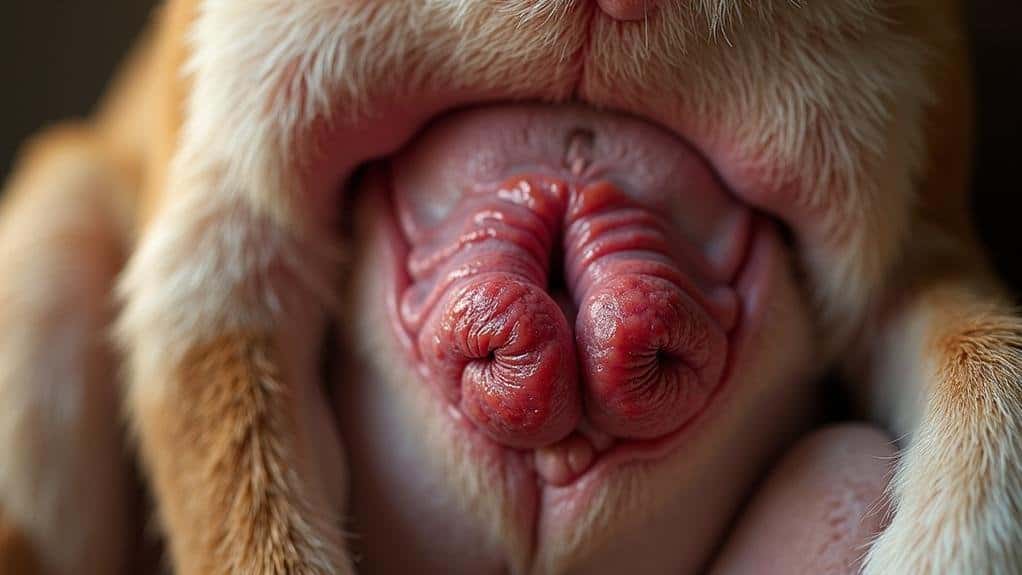
Let's explore the basics of male dog genital anatomy. Understanding your dog's private parts can help you identify potential health issues.
The penis in male dogs consists of three main components: the shaft, glans, and prepuce. The prepuce is a protective sheath covering the glans when it isn't erect. During arousal, the shaft's erectile tissue engorges, allowing for mating.
The glans, or tip of the penis, can change appearance when your dog is excited. It's usually covered by the prepuce when not erect. The penis is covered by a mucous membrane that should appear moist and can range from pale pink to bright red. If you notice it's swollen and red, this could indicate a health concern.
Male dogs have a unique feature called the os penis, a bone that maintains rigidity even when not erect. During arousal, the bulbus glandis swells, creating a visible bump.
It's crucial to be aware of any unusual penile discharge, as this could signal an infection or other health issue. Regular check-ups and monitoring your dog's genital area can help catch problems early.
Common Causes of Swelling
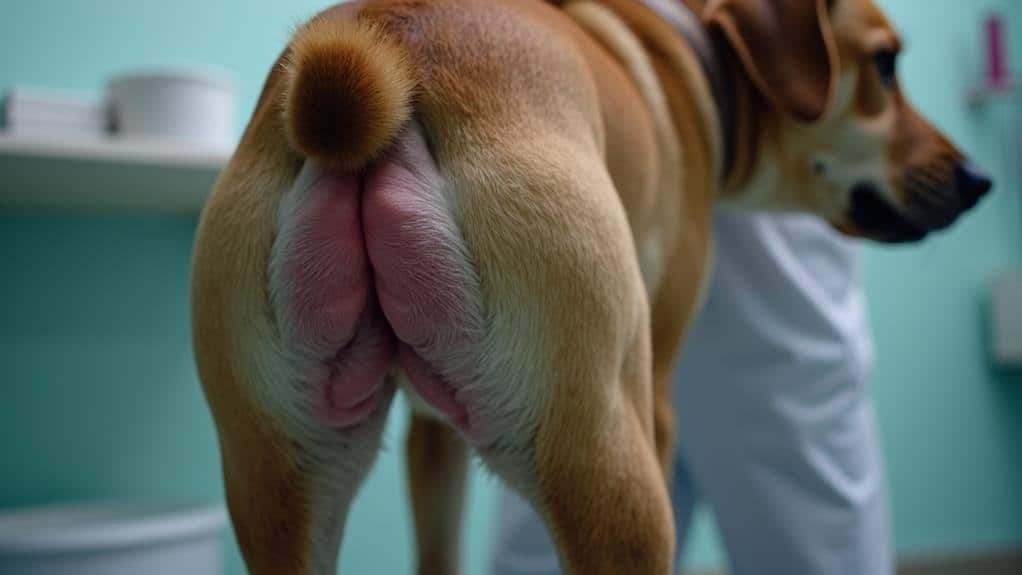
When you notice swelling in your male dog's genital area, several common causes could be at play. One of the most frequent issues is balanoposthitis, an infection that's particularly common in unneutered male dogs. This condition often results in swelling, redness, and discharge, causing discomfort for your pet.
Trauma or injury to your dog's private area can also lead to inflammation and swelling. This might occur due to accidents, bites, or foreign objects. If you suspect an injury, it's vital to have your vet examine your dog promptly.
Allergic reactions can cause irritation and swelling in your male dog's genital region. These reactions may stem from food, environmental factors, or topical substances.
Hormonal changes, especially in unneutered males, can contribute to health issues like benign prostatic hypertrophy (BPH), leading to swelling and discomfort.
Phimosis and paraphimosis are serious conditions that require immediate veterinary attention. These involve problems with the prepuce and can result in significant swelling.
To determine the underlying cause of your male dog's swollen private area, it's important to consult with a veterinarian for proper diagnosis and treatment.
Identifying Associated Symptoms

Recognizing associated symptoms is essential when dealing with swelling in your male dog's genital area. As you observe the swelling and redness at the tip of your dog's penis, you'll want to look for additional signs that may indicate a more serious condition, such as balanoposthitis.
Watch for any discharge from the affected area, which may be yellow, green, or even bloody. You might notice your dog excessively licking his genitals or showing discomfort when urinating. These symptoms can point to urinary tract issues or infections.
Pay attention to behavioral changes too. Your dog might become lethargic, lose interest in breeding, or display increased aggression. In severe cases, he may be unable to retract his penis, a condition called paraphimosis that requires immediate veterinary care.
Other symptoms to look out for include fever, loss of appetite, and unusual urinary habits. These can suggest an underlying infection or health concern related to the swelling.
When to Seek Veterinary Care

For male dog health issues, knowing when to seek veterinary care is essential. If you notice swelling or redness in your dog's penis area, don't hesitate to consult a vet immediately. These symptoms can indicate infections or other serious health conditions that require prompt attention.
Here are three important situations when you should seek veterinary care:
- Difficulty retracting the penis or signs of pain during urination
- Persistent symptoms like abnormal discharge, foul odors, or excessive licking
- Blood in the urine or from the penis
If your dog exhibits any of these symptoms, it's vital to have a professional evaluate him to prevent complications such as paraphimosis or to diagnose and treat potential infections or irritations.
Additionally, watch for changes in your dog's behavior, such as increased aggression or lethargy, alongside physical symptoms. These could indicate underlying health issues that need professional assessment.
Diagnostic Procedures and Tests

After identifying the need for veterinary care, your dog's vet will perform a series of diagnostic procedures and tests to pinpoint the underlying issue. The process typically begins with a thorough veterinary examination of your dog's penis and prepuce. This hands-on evaluation helps identify any foreign bodies, lacerations, or signs of infection that could be causing the swelling and redness.
Your vet may then employ various diagnostic tools to gather more information. Preputial smears and bacterial cultures can detect infections, while cytology on discharge samples provides insights into the nature of the inflammation.
Urinalysis is essential for evaluating your dog's urinary health and ruling out infections or crystals that may contribute to the symptoms. In some cases, imaging tests like X-rays or ultrasounds may be necessary if there's suspicion of foreign bodies or structural issues affecting the penis.
Additionally, blood tests can help rule out systemic health problems that might be impacting your dog's overall well-being and contributing to the observed symptoms. These thorough diagnostic procedures guarantee that your vet can accurately diagnose the issue and develop an effective treatment plan for your furry friend.
Treatment Options and Medications
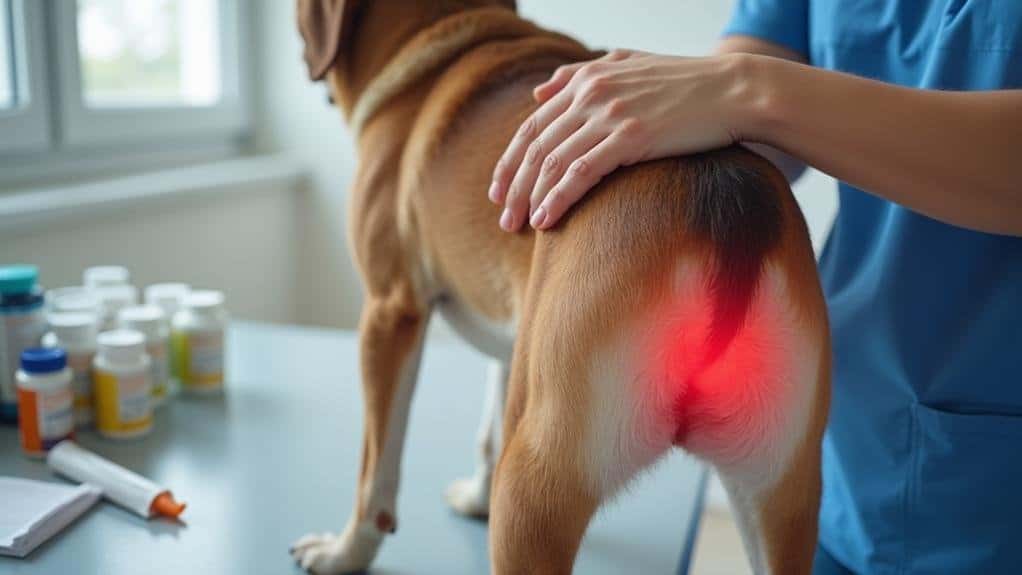
Once your vet has diagnosed the issue affecting your male dog's private area, they'll develop a tailored treatment plan. The approach will depend on the severity of the condition and its underlying cause.
For mild cases, your vet may recommend antiseptic flushes and topical antibiotics to address the inflammation and potential infection.
If your dog's condition is more severe, treatment options may include:
- Oral antibiotics to combat bacterial infections
- Antifungal medications if a fungal infection is suspected
- Surgical intervention or removal of foreign bodies in extreme cases
You can apply over-the-counter hydrocortisone cream to reduce inflammation and discomfort, but always consult your vet before using any medication.
For unneutered males, neutering is often recommended as it can greatly decrease the risk of recurrent infections and related issues.
Home Care and Prevention
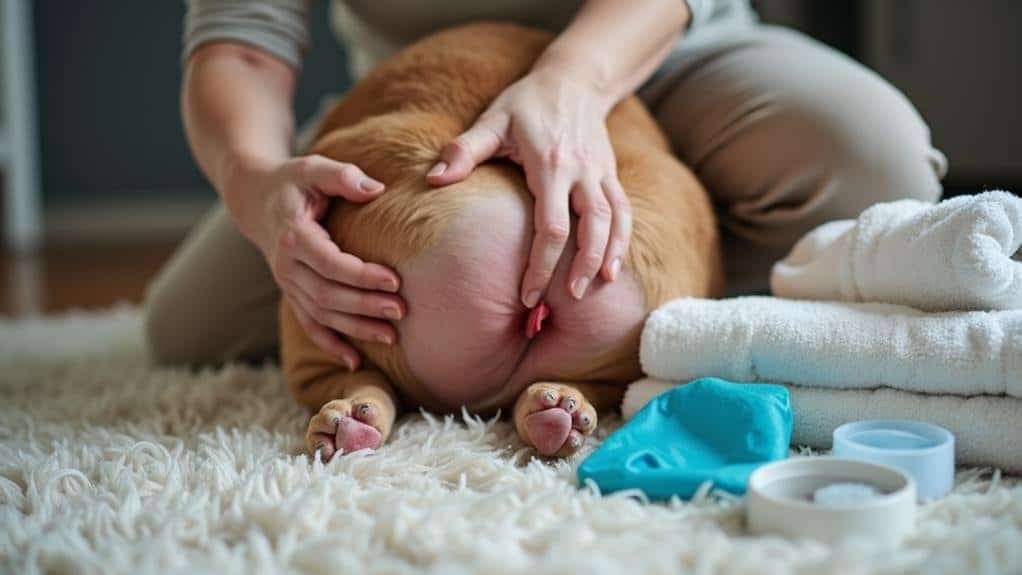
While professional treatment is essential, proper home care and prevention strategies play a key role in maintaining your male dog's genital health. Regularly cleanse your dog's penis and surrounding area with mild antiseptic solutions to prevent infections and promote overall pet health.
Keep an eye out for signs of irritation, such as excessive licking or abnormal discharge, and don't hesitate to consult your veterinarian if these symptoms persist.
To support your dog's penis health, focus on providing a balanced diet that bolsters his immune system and reduces the risk of dietary-related irritations. If your dog is recovering from a genital issue, use an Elizabethan collar to prevent him from licking or biting the affected area, which can exacerbate the problem and slow healing.
Schedule routine check-ups with your veterinarian to catch potential issues early and guarantee your dog's continued well-being. These visits allow for professional monitoring and can help reduce the swelling or other symptoms before they become severe.
Long-Term Management Strategies
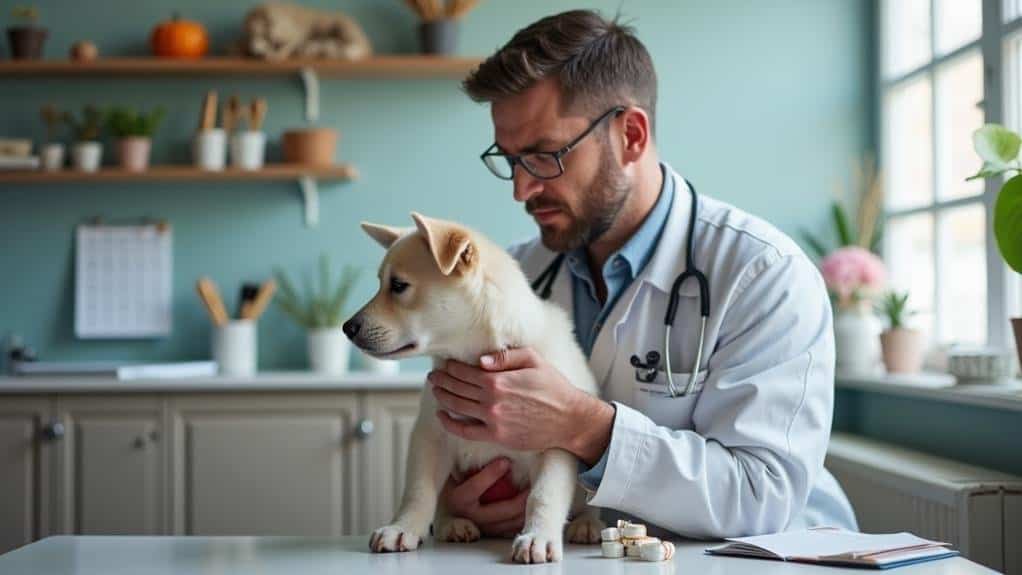
Long-term management of male dog genital health requires a multifaceted approach. To maintain your dog's well-being and prevent serious health issues, you'll need to be proactive and consistent in your care routine.
- Regular monitoring
- Proper hygiene practices
- Veterinary follow-ups
Keep a close eye on your dog's penis or prepuce for any signs of swelling, redness, or discharge. These could indicate abnormal tissue growth or infection.
Implement a routine cleaning schedule using antiseptic washes to prevent infections and manage existing conditions. If you haven't already, consider neutering your dog, as it can greatly reduce the risk of recurrent infections and other related health problems.
Establish a consistent follow-up schedule with your veterinarian to manage chronic conditions and prevent complications from recurring balanoposthitis. This is especially important if your dog has experienced genital issues in the past.
Additionally, provide a balanced diet and avoid known irritants to support overall genital health. By following these long-term strategies, you'll be better equipped to maintain your dog's normal genital function and catch any potential problems early, ensuring timely intervention when necessary.
Frequently Asked Questions
Why Is My Male Dog's Private Area Swollen and Red?
Your dog's swollen, red private area may indicate balanoposthitis, an inflammation often caused by infections, injuries, or health issues. You'll notice discharge, excessive licking, or discomfort during urination. It's essential to consult a vet immediately for proper diagnosis and treatment.
What to Do if Your Dog's Private Area Is Red?
If your dog's private area is red, you should consult a vet immediately. Keep the area clean with mild antiseptic solutions. Monitor for additional symptoms and consider using an Elizabethan collar to prevent licking. Watch for changes in urinary habits.
How to Fix Paraphimosis in Dogs at Home?
To fix paraphimosis at home, you'll need to act quickly. Apply water-soluble lubricant to the exposed penis, gently try to retract it. Use sugar treatment to reduce swelling. If unsuccessful within hours, seek immediate veterinary help.
What Is the Red Thing Sticking Out of My Male Dog?
The red thing you're seeing is likely your dog's penis. It can protrude due to arousal, inflammation, or infection. If it doesn't retract or is accompanied by other symptoms, you should consult a vet immediately.
Conclusion
You've learned about your male dog's swollen, red private area and the potential causes. Remember to monitor for additional symptoms and seek veterinary care when needed. Don't hesitate to ask your vet questions about diagnosis and treatment options. With proper care and attention, you'll help your furry friend feel better. Stay vigilant, follow prevention tips, and maintain good hygiene to keep your dog healthy in the long run.

